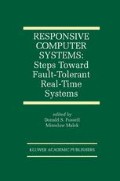Abstract
We present two tests for analyzing deadlock for a class of communicating sequential processes. The tests can be used for deadlock detection in parallel and distributed programs at compile time, or for debugging purposes at run time. They can also be used in conjunction with an algorithm we have for constructing valid execution traces for this class.
Access this chapter
Tax calculation will be finalised at checkout
Purchases are for personal use only
Preview
Unable to display preview. Download preview PDF.
References
K. R. Apt. A static analysis of CSP programs In E. Clarke and D. Kozen, editorsLogics of Programsvolume 164 ofLecture Notes in Computer Sciencepages 1–17. Springer-Verlag, 1983.
J.E. Cuny and L. Snyder. Conversion from data-driven to synchronous execution in loop programs.ACM Transactions on Programming Languages and Systems9(4):599–617, Oct 1987.
J. Ferrante, K.J. Ottenstein, and J.D. Warren. The program dependence graph and its use in optimization.ACM Transactions on Programming Languages and Systems9(3):319–349, July 1987.
S. Hiranandani, K. Kennedy, C. Koelbel, U. Kremer, and C.-W. Tseng. An overview of the Fortran D programming system. Technical Report COMP TR91–154, Rice University, Houston, TX, Mar 1991.
S. Hiranandani, K. Kennedy, and C.-W. Tseng. Compiler support for machine-independent parallel programming in Fortran D. Technical Report COMP TR91–149, Rice University, Houston, TX, 1991.
J. Hafner and P. Narendran. Personal communications, 1991 and 1992.
C.A.H. Hoare.Communicating Sequential Processes.Prentice Hall International, 1985.
D.J. Hatley and I.A. PirbhaiStrategies for Real-Time System Specification.Dorset House, 1988.
M.A. Jackson.System Development.Prentice Hall International, 1986.
P.B. Ladkin and B.B. Simons. Compile-time analysis of communicating processes. Technical Report RJ 8488, IBM Almaden Research Center, Nov 1991. Short version inProceedings of the Sixth ACM International Conference on Supercomputing248–259, ACM Press, 1992.
P.B. Ladkin and B.B. Simons. Simple NP-complete deadlock and reachability problems. Technical Report TR 03.456, IBM Santa Teresa Laboratory, San Jose, CA, Nov 1992.
P.B. Ladkin and B.B. Simons. Static analysis of concurrent communicating loops. Technical Report RJ 8625, IBM Almaden Research Center, Feb 1992.
P.B. Ladkin and B.B. Simons. Static analysis of interprocess communication. To appear as a monograph in the seriesLecture Notes in Computer Science.Springer-Verlag, 1994.
N. Mercouroff. An algorithm for analyzing communicating processes. Technical Report LIX/RR/90/12, Ecole Polytechnique, Laboratoire d’Informatique, Palaiseaux Cedex, France, 1990.
W. Peng and S. Purushothaman. A unified approach to the deadlock detection problem in networks of communicating finite state machines. In E.M. Clarke and R.P. Kurshan, editorsComputer Aided Verification: Proceedings of CAV’90volume 531 ofLecture Notes in Computer Sciencepages 243–252. Springer-Verlag, 1991.
W. Peng and S. Purushothaman. Analysis of a class of communicating finite state machines.Acta Informatica29:499–522, 1992.
J. Reif and S.A. Smolka Data flow analysis of distributed communicating processes.International Journal of Parallel Programming19(1):1–31, Feb 1990.
B.B. Simons. A polynomial time algorithm for compile-time deadlock analysis when the communication graph is a tree. In Preparation.
R.N. Taylor. A general-purpose algorithm for analyzing concurrent programs.Communications of the ACM26(5):362–376, May 1983.
Author information
Authors and Affiliations
Editor information
Editors and Affiliations
Rights and permissions
Copyright information
© 1995 Springer Science+Business Media New York
About this chapter
Cite this chapter
Ladkin, P.B., Simons, B.B. (1995). Static Deadlock Analysis for CSP-Type Communications. In: Fussell, D.S., Malek, M. (eds) Responsive Computer Systems: Steps Toward Fault-Tolerant Real-Time Systems. The Springer International Series in Engineering and Computer Science, vol 297. Springer, Boston, MA. https://doi.org/10.1007/978-1-4615-2271-3_5
Download citation
DOI: https://doi.org/10.1007/978-1-4615-2271-3_5
Publisher Name: Springer, Boston, MA
Print ISBN: 978-0-7923-9563-8
Online ISBN: 978-1-4615-2271-3
eBook Packages: Springer Book Archive

